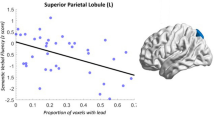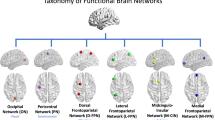Abstract
Objective
In this paper, we develop a dynamic functional network connectivity (FNC) analysis approach using correlations between windowed time-courses of different brain networks (components) estimated via spatial independent component analysis (sICA). We apply the developed method to fMRI data to evaluate it and to study task-modulation of functional connections.
Materials and methods
We study the theoretical basis of the approach, perform a simulation analysis and apply it to fMRI data from schizophrenia patients (SP) and healthy controls (HC). Analyses on the fMRI data include: (a) group sICA to determine regions of significant task-related activity, (b) static and dynamic FNC analysis among these networks by using maximal lagged-correlation and time–frequency analysis, and (c) HC–SP group differences in functional network connections and in task-modulation of these connections.
Results
This new approach enables an assessment of task-modulation of connectivity and identifies meaningful inter-component linkages and differences between the two study groups during performance of an auditory oddball task (AOT). The static FNC results revealed that connectivities involving medial visual–frontal, medial temporal–medial visual, parietal–medial temporal, parietal–medial visual and medial temporal–anterior temporal were significantly greater in HC, whereas only the right lateral fronto-parietal (RLFP)–orbitofrontal connection was significantly greater in SP. The dynamic FNC revealed that task-modulation of motor–frontal, RLFP–medial temporal and posterior default mode (pDM)–parietal connections were significantly greater in SP, and task modulation of orbitofrontal–pDM and medial temporal–frontal connections were significantly greater in HC (all P < 0.05).
Conclusion
The task-modulation of dynamic FNC provided findings and differences between the two groups that are consistent with the existing hypothesis that schizophrenia patients show less segregated motor, sensory, cognitive functions and less segregated default mode network activity when engaged with a task. Dynamic FNC, based on sICA, provided additional results which are different than, but complementary to, those of static FNC. For example, it revealed dynamic changes in default mode network connectivities with other regions which were significantly different in schizophrenia in terms of task-modulation, findings which were not possible to discover by static FNC.
Similar content being viewed by others
Abbreviations
- fMRI:
-
Functional magnetic resonance imaging
- FC:
-
Functional connectivity
- FNC:
-
Functional network connectivity
- DFNC:
-
Dynamic functional network connectivity
- ICA:
-
Independent component analysis
- sICA:
-
Spatial independent component analysis
- SP:
-
Schizophrenia patients
- HC:
-
Healthy controls
- AOT:
-
Auditory oddball task
References
Biswal B, Yetkin FZ, Haughton VM et al (1995) Functional connectivity in the motor cortex of resting human brain using echo-planar MRI. Magn Reson Med 34: 537–541
Biswal BB, Van Kylen J, Hyde JS (1997) Simultaneous assessment of flow and BOLD signals in resting-state functional connectivity maps. NMR Biomed 10: 165–170
Lowe MJ, Mock BJ, Sorenson JA (1998) Functional connectivity in single and multislice echoplanar imaging using resting-state fluctuations. Neuroimage 7: 119–132
Cordes D, Haughton VM, Arfanakis K et al (2000) Mapping functionally related regions of brain with functional connectivity MR imaging. AJNR Am J Neuroradiol 21: 1636–1644
Cordes D, Haughton V, Carew JD et al (2002) Hierarchical clustering to measure connectivity in fMRI resting-state data. Magn Reson Imaging 20: 305–317
Jafri MJ, Pearlson GD, Stevens M et al (2008) A method for functional network connectivity among spatially independent resting-state components in schizophrenia. Neuroimage 39: 1666–1681
Assaf M, Jagannathan K, Calhoun V et al (2009) Temporal sequence of hemispheric network activation during semantic processing: a functional network connectivity analysis. Brain Cogn 70: 238–246
Calhoun VD, Kiehl KA, Pearlson GD (2008) Modulation of temporally coherent brain networks estimated using ICA at rest and during cognitive tasks. Hum Brain Mapp 29: 828–838
Maldjian JA, Laurienti PJ, Kraft RA et al (2003) An automated method for neuroanatomic and cytoarchitectonic atlas-based interrogation of fMRI data sets. Neuroimage 19: 1233–1239
Baumgartner R, Windischberger C, Moser E (1998) Quantification in functional magnetic resonance imaging: fuzzy clustering vs. correlation analysis. Magn Reson Imaging 16: 115–125
Baumgartner R, Scarth G, Teichtmeister C et al (1997) Fuzzy clustering of gradient-echo functional MRI in the human visual cortex. Part I: reproducibility. J Magn Reson Imaging 7: 1094–1101
Lu N, Shan BC, Xu JY et al (2007) An improved temporal clustering analysis method applied to whole-brain data in fMRI study. Magn Reson Imaging 25: 57–62
Meyer FG, Chinrungrueng J (2005) Spatiotemporal clustering of fMRI time series in the spectral domain. Med Image Anal 9: 51–68
Backfrieder W, Baumgartner R, Samal M et al (1996) Quantification of intensity variations in functional MR images using rotated principal components. Phys Med Biol 41: 1425–1438
Friman O, Cedefamn J, Lundberg P et al (2001) Detection of neural activity in functional MRI using canonical correlation analysis. Magn Reson Med 45: 323–330
McKeown MJ, Makeig S, Brown GG et al (1998) Analysis of fMRI data by blind separation into independent spatial components. Hum Brain Mapp 6: 160–188
Neufang S, Fink GR, Herpertz-Dahlmann B et al (2008) Developmental changes in neural activation and psychophysiological interaction patterns of brain regions associated with interference control and time perception. Neuroimage 43: 399–409
Buchel C, Friston KJ (1997) Modulation of connectivity in visual pathways by attention: cortical interactions evaluated with structural equation modelling and fMRI. Cereb Cortex 7: 768–778
Astolfi L, de Vico Fallani F, Cincotti F et al (2007) Imaging functional brain connectivity patterns from high-resolution EEG and fMRI via graph theory. Psychophysiology 44: 880–893
Friston KJ, Harrison L, Penny W (2003) Dynamic causal modelling. Neuroimage 19: 1273–1302
Bhattacharya S, Ringo Ho MH, Purkayastha S (2006) A Bayesian approach to modeling dynamic effective connectivity with fMRI data. Neuroimage 30: 794–812
Bell AJ, Sejnowski TJ (1995) An information-maximization approach to blind separation and blind deconvolution. Neural Comput 7: 1129–1159
Calhoun VD, Adali T, Pearlson GD et al (2001) A method for making group inferences from functional MRI data using independent component analysis. Hum Brain Mapp 14: 140–151
Bai F, Zhang Z, Watson DR et al (2009) Abnormal functional connectivity of hippocampus during episodic memory retrieval processing network in amnestic mild cognitive impairment. Biol Psychiatry 65: 951–958
Calhoun VD, Liu J, Adali T (2009) A review of group ICA for fMRI data and ICA for joint inference of imaging, genetic, and ERP data. Neuroimage 45: S163–S172
Karvanen J, Theis FJ (2004) Spatial ICA of fMRI data in time windows. In: 24th International workshop on Bayesian inference and maximum entropy methods in science and engineering. AIP, pp 312–319
Eichele T, Debener S, Calhoun VD et al (2008) Prediction of human errors by maladaptive changes in event-related brain networks. Proc Natl Acad Sci USA 105: 6173–6178
Calhoun VD, Maciejewski PK, Pearlson GD et al (2008) Temporal lobe and “default” hemodynamic brain modes discriminate between schizophrenia and bipolar disorder. Hum Brain Mapp 29: 1265–1275
Kiehl KA, Liddle PF (2001) An event-related functional magnetic resonance imaging study of an auditory oddball task in schizophrenia. Schizophr Res 48: 159–171
Kiehl KA, Liddle PF (2003) Reproducibility of the hemodynamic response to auditory oddball stimuli: a six-week test-retest study. Hum Brain Mapp 18: 42–52
Kiehl KA, Stevens MC, Celone K et al (2005) Abnormal hemodynamics in schizophrenia during an auditory oddball task. Biol Psychiatry 57: 1029–1040
MacDonald AW, Schulz SC (2009) What we know: findings that every theory of schizophrenia should explain. Schizophr Bull 35: 493–508
Palacios-Araus L, Herran A, Sandoya M et al (1995) Analysis of positive and negative symptoms in schizophrenia. A study from a population of long-term outpatients. Acta Psychiatr Scand 92: 178–182
Braff DL, Geyer MA (1990) Sensorimotor gating and schizophrenia. Human and animal model studies. Arch Gen Psychiatry 47: 181–188
Friston KJ, Frith CD (1995) Schizophrenia: a disconnection syndrome? Clin Neurosci 3:89–97
Lu H, Zuo Y, Gu H et al (2007) Synchronized delta oscillations correlate with the resting-state functional MRI signal. Proc Natl Acad Sci USA 104: 18265–18269
McIntosh DN, Miller LJ, Shyu V et al (1999) Sensory-modulation disruption, electrodermal responses, and functional behaviors. Dev Med Child Neurol 41: 608–615
Garrity AG, Pearlson GD, McKiernan K et al (2007) Aberrant “default mode” functional connectivity in schizophrenia. Am J Psychiatry 164: 450–457
Menon V, Anagnoson RT, Glover GH et al (2001) Functional magnetic resonance imaging evidence for disrupted basal ganglia function in schizophrenia. Am J Psychiatry 158: 646–649
Menon V, Anagnoson RT, Mathalon DH et al (2001) Functional neuroanatomy of auditory working memory in schizophrenia: relation to positive and negative symptoms. Neuroimage 13: 433–446
Stephan KE, Magnotta VA, White T et al (2001) Effects of olanzapine on cerebellar functional connectivity in schizophrenia measured by fMRI during a simple motor task. Psychol Med 31: 1065–1078
Honey GD, Fletcher PC (2006) Investigating principles of human brain function underlying working memory: what insights from schizophrenia? Neuroscience 139:59–71
Honey GD, Pomarol-Clotet E, Corlett PR et al (2005) Functional dysconnectivity in schizophrenia associated with attentional modulation of motor function. Brain 128: 2597–2611
Meyer-Lindenberg AS, Olsen RK, Kohn PD et al (2005) Regionally specific disturbance of dorsolateral prefrontal-hippocampal functional connectivity in schizophrenia. Arch Gen Psychiatry 62: 379–386
Micheloyannis S, Pachou E, Stam CJ et al (2006) Small-world networks and disturbed functional connectivity in schizophrenia. Schizophr Res 87: 60–66
Ende G, Braus DF, Walter S et al (2000) Effects of age, medication, and illness duration on the N-acetyl aspartate signal of the anterior cingulate region in schizophrenia. Schizophr Res 41: 389–395
Buchel C, Friston KJ (1998) Dynamic changes in effective connectivity characterized by variable parameter regression and Kalman filtering. Hum Brain Mapp 6: 403–408
Sakoglu U, Calhoun VD (2009) Temporal dynamics of functional network connectivity at rest: a comparison of schizophrenia patients and healthy controls. In: The 15th annual meeting of the organization for human brain mapping. Organization for Human Brain Mapping, San Francisco, CA
Sakoglu U, Michael A, Calhoun VD (2009) Classification of schizophrenia patients vs healthy controls with dynamic functional network connectivity In: The 15th annual meeting of the organization for human brain mapping. Organization for Human Brain Mapping, San Francisco, CA
First MB, Spitzer RL, Gibbon M et al (1995) Structured clinical interview for DSM-IV axis I disorders-patient edition (SCID-I/P, Version 2.0). Biometrics Research Department, New York State Psychiatric Institute, New York
Kiehl KA, Stevens MC, Laurens KR et al (2005) An adaptive reflexive processing model of neurocognitive function: supporting evidence from a large scale (n = 100) fMRI study of an auditory oddball task. Neuroimage 25: 899–915
Kiehl KA, Laurens KR, Duty TL et al (2001) Neural sources involved in auditory target detection and novelty processing: an event-related fMRI study. Psychophysiology 38: 133–142
Freire L, Roche A, Mangin JF (2002) What is the best similarity measure for motion correction in fMRI time series? IEEE Trans Med Imaging 21:470–484
Li YO, Adali T, Calhoun VD (2007) Estimating the number of independent components for functional magnetic resonance imaging data. Hum Brain Mapp 28: 1251–1266
Chaogan Y, Dongqiang L, Yong H et al (2009) Spontaneous brain activity in the default mode network is sensitive to different resting-state conditions with limited cognitive load. PLOS 4: e5743–e5753
Burge J, Lane T, Link H et al (2009) Discrete dynamic Bayesian network analysis of fMRI data. Hum Brain Mapp 30: 122–137
Author information
Authors and Affiliations
Corresponding author
Rights and permissions
About this article
Cite this article
Sakoğlu, Ü., Pearlson, G.D., Kiehl, K.A. et al. A method for evaluating dynamic functional network connectivity and task-modulation: application to schizophrenia. Magn Reson Mater Phy 23, 351–366 (2010). https://doi.org/10.1007/s10334-010-0197-8
Received:
Revised:
Accepted:
Published:
Issue Date:
DOI: https://doi.org/10.1007/s10334-010-0197-8




